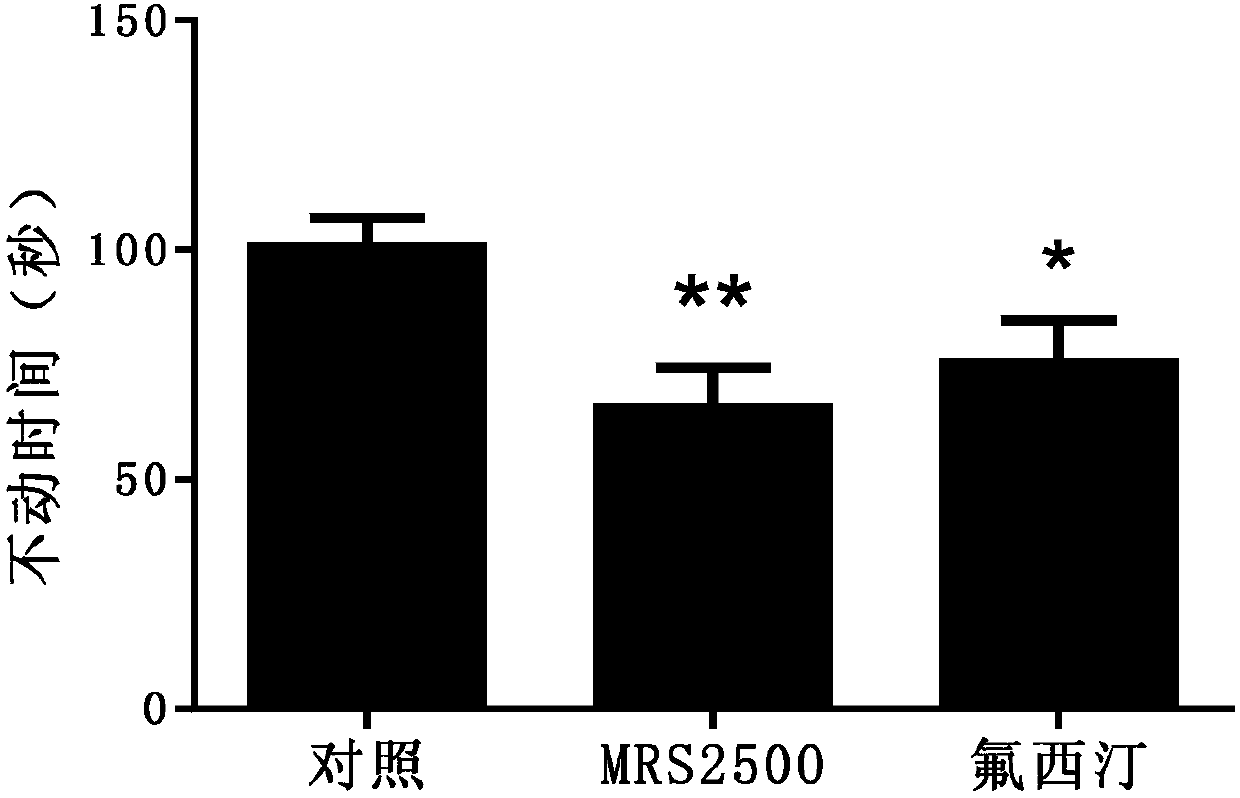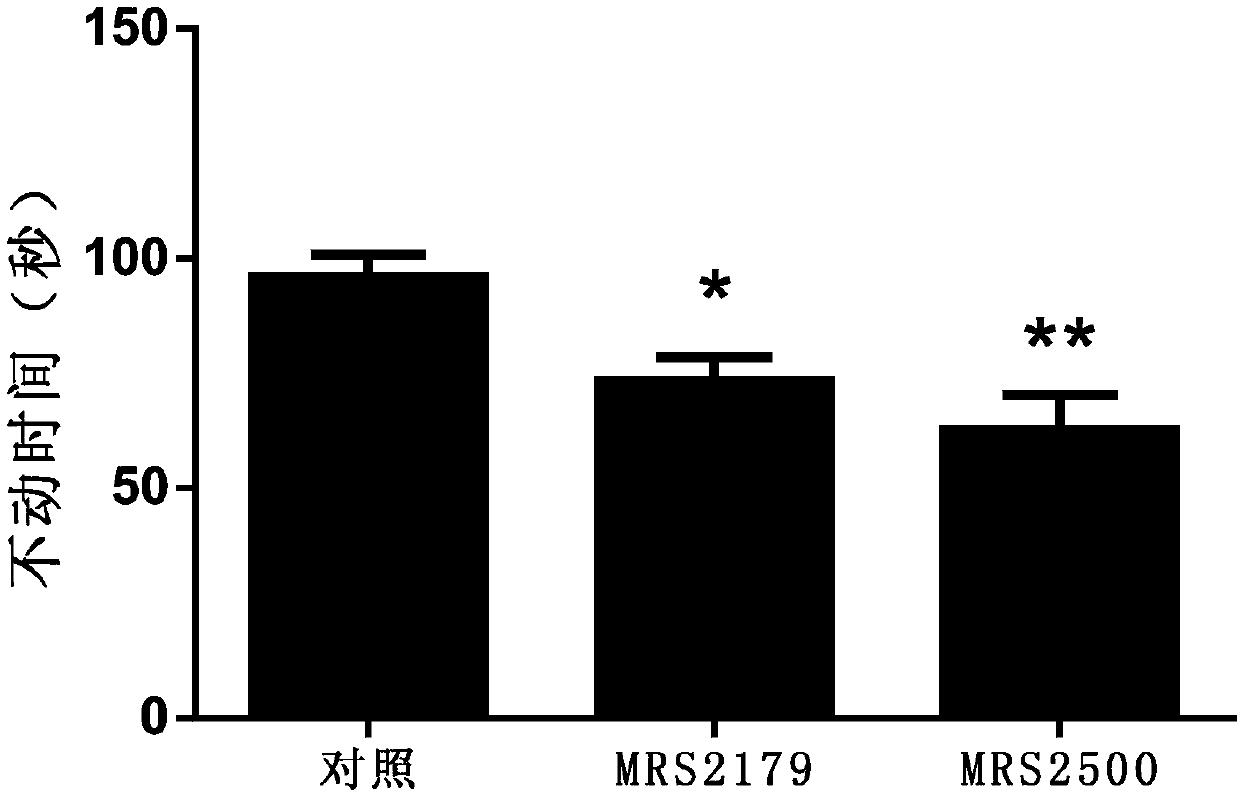Application of P2Y1 receptor and blocking agent of P2Y1 receptor in prevention and treatment of anti-depression symptom and/or anti-anxiety symptom
A P2Y1, antidepressant technology, applied in the field of biopharmaceutical medicine, can solve the problems of slow onset of antidepressant drugs, low drug efficacy, insensitivity, etc., and achieve good application prospects and research value.
- Summary
- Abstract
- Description
- Claims
- Application Information
AI Technical Summary
Problems solved by technology
Method used
Image
Examples
Embodiment 1P2
[0032] Example 1 Pharmacological Experimental Study of Antidepressant and Antianxiety of P2Y1 Receptor Specific Blockers MRS2500 and MRS2179
[0033] 1. Forced swimming test (FST):
[0034] In 1977, Porsolt proposed the forced swimming test, which was first used in rats and later extended to mice. The forced swimming test is used to screen antidepressant drugs, and it is found that antidepressant drugs can reduce the immobility time of forced swimming mice. This model is one of the most commonly used models for screening antidepressant drugs. The experimental steps are as follows: After the experimental mice had adapted to the behavioral laboratory for at least 60 minutes in advance, the following experiments were carried out: a single mouse was placed in a cylindrical glass tank with a water depth of 23 cm (height: 45 cm; diameter: 19 cm), the water temperature At 22-25°C, perform forced swimming for 6 minutes. The accumulated immobility time within 4 minutes after recordin...
Embodiment 2P2Y1
[0045] Example 2 Depression-like behavior screening of P2Y1 receptor knockout mice
[0046] 1. Forced swimming experiment
[0047] Experimental method: P2Y1 receptor whole-body knockout mice and wild-type mice were subjected to a 6-minute forced swimming test, and the swimming immobility time within 4 minutes after that was recorded.
[0048] Experimental animals: P2Y1 mice were purchased from Jax (strain number: 009131). This gene has only one coding exon, and most of the coding regions were disturbed by PGK neo cassette. The resulting 129 chimeric mice were backcrossed with C57BL / 6J 12 generation. The experimental animals were kept in a 12 / 12-hour light-dark environment, free to eat and drink.
[0049] Experimental results: if Figure 5 As shown, the immobility time in the forced swimming test was significantly reduced in P2Y1 receptor knockout mice compared with wild-type mice. The results showed that after the expression level of P2Y1 receptor was downregulated, the mi...
Embodiment 3
[0054] Example 3 The experiment of using RNA interference technology to verify P2Y1 receptor as a new antidepressant target
[0055] Experimental animals: C57BL / 6J mice, SPF grade, male, body weight 20±2g, all animals were provided by Experimental Animal Center of Southern Medical University (Guangzhou, China). The mice were raised in separate cages in an SPF animal breeding room, with 3 to 4 mice per cage, room temperature: 24±1°C; light and dark cycle: 12h / 12h; light time: 7:00am~7:00pm; relative humidity: 70~ 85%; the indoor environment is quiet, and mice can eat and drink freely. The experiments were carried out from 1:00 to 5:00 in the afternoon. Before the experiment, the mice would enter the experimental environment in advance to adapt, and the experimenters would touch them to adapt.
[0056] Experimental method: Microinject 0.5ul (0.1ul) of interfering RNA molecule adeno-associated virus (shRNA) into the ventral dorsal tegmental region (angle 7°, AP: -3.2mm, ML: 1.0m...
PUM
 Login to View More
Login to View More Abstract
Description
Claims
Application Information
 Login to View More
Login to View More - R&D
- Intellectual Property
- Life Sciences
- Materials
- Tech Scout
- Unparalleled Data Quality
- Higher Quality Content
- 60% Fewer Hallucinations
Browse by: Latest US Patents, China's latest patents, Technical Efficacy Thesaurus, Application Domain, Technology Topic, Popular Technical Reports.
© 2025 PatSnap. All rights reserved.Legal|Privacy policy|Modern Slavery Act Transparency Statement|Sitemap|About US| Contact US: help@patsnap.com



